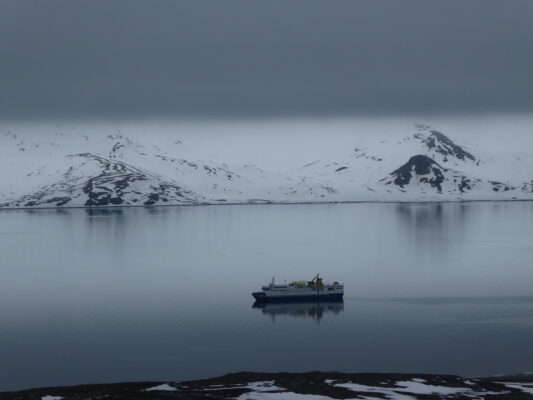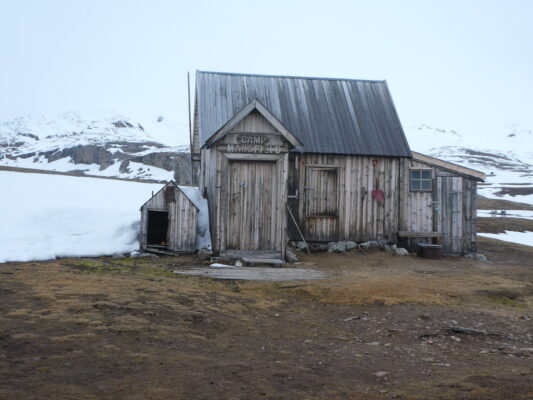Svalbard is a Norwegian archipelago located north of the Arctic Circle, east of Greenland and about eight hundred miles south of the North Pole. The official discovery in 1596 was by the Dutch, who called it Spitsbergen meaning Pointed Mountains. In addition to the Dutch, the English, Russians, and Norwegians established whaling, hunting, and mining industries, followed by polar expeditions and scientific research. As a result of the 1920 Spitsbergen Treaty originally signed by nine nations, the archipelago was made Norwegian territory and renamed Svalbard, Norse for Cold Edge. I wanted to go while there still are ice and polar bears.
In Longyearbyen, the largest town with a population of 2,040, Juliet and I board the Ocean Nova, a small ship welcoming seventy passengers, for an eleven day expedition partially circumnavigating the group of islands that comprise Svalbard. Located from approximately 76° to 80° N latitude and because it is almost the summer solstice, we have twenty-four hours of daylight.

It is cold and snowy here. Back home in Oakland, it is 80 degrees and sunny. I keep asking myself why I come to these frozen climates when I don’t like the cold!
What I see on day one is the answer: a huge cream-colored polar bear stretched out in the snow, blissfully cooling himself, rear legs and big brown paws splayed out behind him.

Two great brown walruses cuddling up on the ice and another two hundred cuddling up on the sand.



A pod of snow white beluga whales, maybe thirty of them, feeding and diving just off the edge of the ice. Bright orange and yellow-beaked puffins skittering low across the water. Fulmars (members of the Albatross family) gliding on air currents alongside the ship, details of their wings and eyes so clear. Massive glaciers sliding down to the fjords, sun slipping through heavy cloud cover, glistening on the water.




We hike through deep crunchy snow on an island where marble was quarried (unsuccessfully, we’re told) in the early twentieth century and see remnants of the mining paraphernalia and basic dwellings of the miners.


We zodiac along the faces of several towering glaciers and ride over the crackling brash ice below, which has been swept together by the wind, creating quite a visual and aural riot.

A polar bear is sighted at least a mile away and we go out on deck hoping that he will come toward the ship which is locked in an ice floe. Slowly, he makes his way across the vast expanse of white, stopping to look and sniff the air as if wondering what this large obstacle in front of him could be.

Photo courtesy of Juliet Nellis

It is fascinating to watch his approach through binoculars and finally to photograph him as he gets nearer.

On another hike through heavy wet snow, some of us sink in hip deep. We see Arctic foxes shedding their white winter coats for darker summer coats and looking rather tatty in the transition. What looks like a male ptarmigan sitting quietly on the tundra like a giant cotton ball turns out to be a fox still in its winter whites curled up with its tail in front of its face. A single grey reindeer is feeding on whatever he can find on the dry rocky earth. Alas, these critters are shy and too far away to be photographed.
On nearly every hike, we traverse different terrain: glacial moraine, glacial ice, snow, and mud—often very steep, boggy, or both. We trek to a Little Auk colony of fifty thousand breeding pairs of birds. They fly in loops, shrieking until the foxes looking to eat their eggs go away.
When not out on the zodiacs or exploring on foot, we are treated to a curriculum of history, geology, glaciology, ornithology, and marine biology by the knowledgeable and entertaining guides. Toward the end of the voyage, they give us a quiz to find out just how much we’ve been paying attention!
The scenery everywhere is splendid and yet the future based on recent observed changes is dire. The amount of sea ice is rapidly decreasing. The extent of it in April 2019 was the lowest ever recorded. Thick old sea ice is diminishing, and complete loss is now expected between 2035 and 2040. Glaciers have retreated dramatically. The implications of these changes is of great consequence not only environmentally, but also politically, socially, economically, and existentially. While there are many climatic conditions humans can’t control, we can control the release of carbon dioxide into the atmosphere. Studies show that human-caused release of CO2 is far greater than that caused by natural phenomena such as volcanoes and is the most significant cause of climatic degradation. We have the ability. We just have to have the will.





13 Comments
Beautiful and heart-breakingly fragile.
Your writing is compelling!
Absolutely beautiful photos!! Really enjoyed.
Fantastic views of another world that I am not familiar with but very intrigued by it. Continue having these great adventures and keeping us informed!!!
Enjoy reading about your adventures. This one looks incredible, albeit quite cold for a Florida girl. Keep up the wonderful story telling.
Glad you got to see so much wildlife, especially Polar bears!!
Fabulous photos! We are off to Alaska soon and will send you some photos in reply!
Stunning Adele, your photographs and words are compelling. How sad those in leadership positions are largely deaf to the planet’s dire situation.
Nice to see you two travelling together again! What a great place to be during the solstice. Please consider a Canadian Rockies hiking vacation sometime.
I’m living vicariously through you! What amazing experience.
Gorgeous photos Adele, looks like an amazing trip!
My Adele, you do travel a lot I believe we met in Kyoto!
Lovely photos and interesting observations.
Thank you so much .
Michèle
Our Hill’s champion continues to amaze and entertain us. Love that you are rewarded with great wildlife sightings and spectacular vistas. Keep on trucking.
Amazing trip Adele, as always. And your descriptions and photos make even the
least hardy of us want to try and make this journey. What’s more, you had a perfect traveling companion to share these rare experiences with.